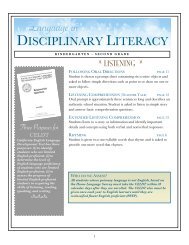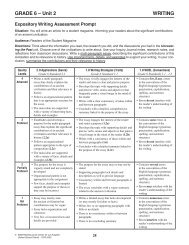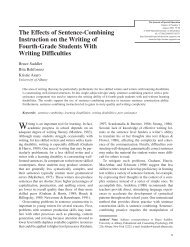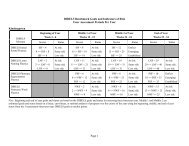Beyond Phonics: Integrated Decoding and Spelling Instruction ...
Beyond Phonics: Integrated Decoding and Spelling Instruction ...
Beyond Phonics: Integrated Decoding and Spelling Instruction ...
Create successful ePaper yourself
Turn your PDF publications into a flip-book with our unique Google optimized e-Paper software.
DECODING AND SPELLING— WORD ORIGIN AND STRUCTURE 271peat the word, listen for syllables <strong>and</strong> try to identify common affixes <strong>and</strong>roots. Teachers encourage their students to use letter-sound corespondencesonly after they attempt the morpheme <strong>and</strong> syllable strategies.In this unit, students also learn productive spelling rules, e.g., rulesfor adding suffixes, to assist in spelling words from dictation. These rulescan be divided into six basic categories:1. Vowel-consonant-e words (made, these, bike, vote, cute)2. One-syllable words ending in f, l, s, z immediately after one shortvowel (cliff, smell, class, buzz)3. One-syllable words ending in /k/, /ch/, /j/ sounds immediately afterone short vowel (stick, black; fetch, notch; fudge, bridge)4. Adding suffixes to base words:a. One syllable words with one short vowel followed by one consonant<strong>and</strong> adding a suffix beginning with a vowel: Double finalconsonant (bigger, swimming, but gladly <strong>and</strong> shorter) (Thisrule differs slightly for multisyllabic base words.)b. Words ending in vowel-consonant-e drop the e when the suffixbegins with a vowel (blaming, but blameless; timed, but timely)c. Words ending in y when preceded by a consonant change the yto i when adding a suffix [unless the suffix begins with i] (try,tried, but trying; copy, copied, but copyist)5. Syllable division (See above)6. Plural rulesLesson ProceduresThese lessons are designed to be presented in 30–45-minute sessions.Teachers first introduce students to the structural or conceptual focusof the limit. In each lesson students read <strong>and</strong> spell numerous wordsrelated to each new pattern. The final lesson in each unit should review<strong>and</strong> summarize the major points.Each lesson entails a small number of steps carried out in a certainorder. The lesson opening provides the purpose <strong>and</strong> goals for the sessionas well as introducing the new pattern or concept. In the middle section ofthe lesson, students become familiar with the decoding concepts <strong>and</strong> patterns.It is here that teachers may provide visual <strong>and</strong> auditory drills forfrequently used patterns. For example, in order to familiarize studentswith consonant blends, teachers may (a) define blends, (b) have studentsread blend cards, (c) say blend sounds as students write the appropriateletters, (d) have students read a list of words with consonant blends on theboard, (e) ask students to generate new words for specific blends <strong>and</strong>(f) dictate words containing blends for spelling. The lessons allow the studentsto think of each concept <strong>and</strong> strategy as a problem-solving activity.Figure 2 illustrates possible middle activities for a lesson reviewingoo/__/moon <strong>and</strong> introducing oo/__/book.The lesson closes as students reflect upon <strong>and</strong> summarize the major






